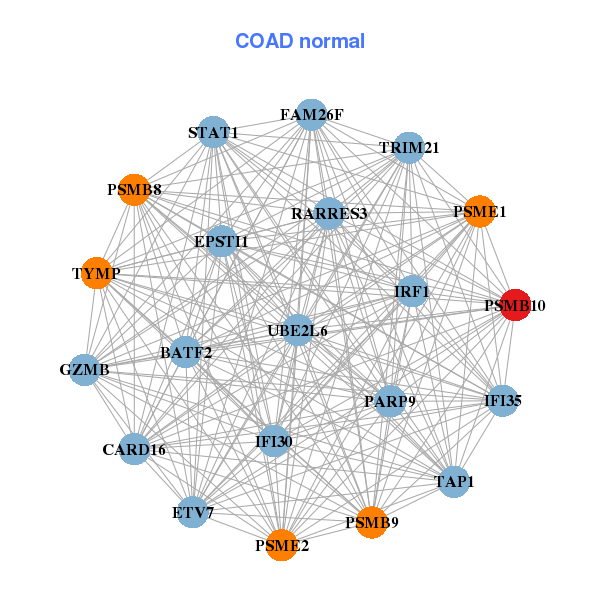|
||||||||||||||||||||
| |
| Phenotypic Information (metabolism pathway, cancer, disease, phenome) |
| |
| |
| Gene-Gene Network Information: Co-Expression Network, Interacting Genes & KEGG |
| |
|
| Gene Summary for PSMB10 |
| Basic gene info. | Gene symbol | PSMB10 |
| Gene name | proteasome (prosome, macropain) subunit, beta type, 10 | |
| Synonyms | LMP10|MECL1|beta2i | |
| Cytomap | UCSC genome browser: 16q22.1 | |
| Genomic location | chr16 :67968406-67970780 | |
| Type of gene | protein-coding | |
| RefGenes | NM_002801.3, | |
| Ensembl id | ENSG00000205220 | |
| Description | low molecular mass protein 10macropain subunit MECl-1multicatalytic endopeptidase complex subunit MECl-1proteasome MECl-1proteasome catalytic subunit 2iproteasome subunit MECL1proteasome subunit beta 7iproteasome subunit beta type-10proteasome sub | |
| Modification date | 20141207 | |
| dbXrefs | MIM : 176847 | |
| HGNC : HGNC | ||
| Ensembl : ENSG00000205220 | ||
| HPRD : 01465 | ||
| Vega : OTTHUMG00000137553 | ||
| Protein | UniProt: go to UniProt's Cross Reference DB Table | |
| Expression | CleanEX: HS_PSMB10 | |
| BioGPS: 5699 | ||
| Gene Expression Atlas: ENSG00000205220 | ||
| The Human Protein Atlas: ENSG00000205220 | ||
| Pathway | NCI Pathway Interaction Database: PSMB10 | |
| KEGG: PSMB10 | ||
| REACTOME: PSMB10 | ||
| ConsensusPathDB | ||
| Pathway Commons: PSMB10 | ||
| Metabolism | MetaCyc: PSMB10 | |
| HUMANCyc: PSMB10 | ||
| Regulation | Ensembl's Regulation: ENSG00000205220 | |
| miRBase: chr16 :67,968,406-67,970,780 | ||
| TargetScan: NM_002801 | ||
| cisRED: ENSG00000205220 | ||
| Context | iHOP: PSMB10 | |
| cancer metabolism search in PubMed: PSMB10 | ||
| UCL Cancer Institute: PSMB10 | ||
| Assigned class in ccmGDB | C | |
| Top |
| Phenotypic Information for PSMB10(metabolism pathway, cancer, disease, phenome) |
| Cancer | CGAP: PSMB10 |
| Familial Cancer Database: PSMB10 | |
| * This gene is included in those cancer gene databases. |
|
|
|
|
|
| . | ||||||||||||||
Oncogene 1 | Significant driver gene in | |||||||||||||||||||
| cf) number; DB name 1 Oncogene; http://nar.oxfordjournals.org/content/35/suppl_1/D721.long, 2 Tumor Suppressor gene; https://bioinfo.uth.edu/TSGene/, 3 Cancer Gene Census; http://www.nature.com/nrc/journal/v4/n3/abs/nrc1299.html, 4 CancerGenes; http://nar.oxfordjournals.org/content/35/suppl_1/D721.long, 5 Network of Cancer Gene; http://ncg.kcl.ac.uk/index.php, 1Therapeutic Vulnerabilities in Cancer; http://cbio.mskcc.org/cancergenomics/statius/ |
| REACTOME_METABOLISM_OF_AMINO_ACIDS_AND_DERIVATIVES REACTOME_METABOLISM_OF_MRNA REACTOME_METABOLISM_OF_RNA | |
| OMIM | |
| Orphanet | |
| Disease | KEGG Disease: PSMB10 |
| MedGen: PSMB10 (Human Medical Genetics with Condition) | |
| ClinVar: PSMB10 | |
| Phenotype | MGI: PSMB10 (International Mouse Phenotyping Consortium) |
| PhenomicDB: PSMB10 | |
| Mutations for PSMB10 |
| * Under tables are showing count per each tissue to give us broad intuition about tissue specific mutation patterns.You can go to the detailed page for each mutation database's web site. |
| There's no structural variation information in COSMIC data for this gene. |
| * From mRNA Sanger sequences, Chitars2.0 arranged chimeric transcripts. This table shows PSMB10 related fusion information. |
| ID | Head Gene | Tail Gene | Accession | Gene_a | qStart_a | qEnd_a | Chromosome_a | tStart_a | tEnd_a | Gene_a | qStart_a | qEnd_a | Chromosome_a | tStart_a | tEnd_a |
| BE832990 | FBXW5 | 32 | 82 | 9 | 139835137 | 139835187 | PSMB10 | 78 | 133 | 16 | 67970327 | 67970383 | |
| Top |
| There's no copy number variation information in COSMIC data for this gene. |
| Top |
|
 |
| Top |
| Stat. for Non-Synonymous SNVs (# total SNVs=12) | (# total SNVs=9) |
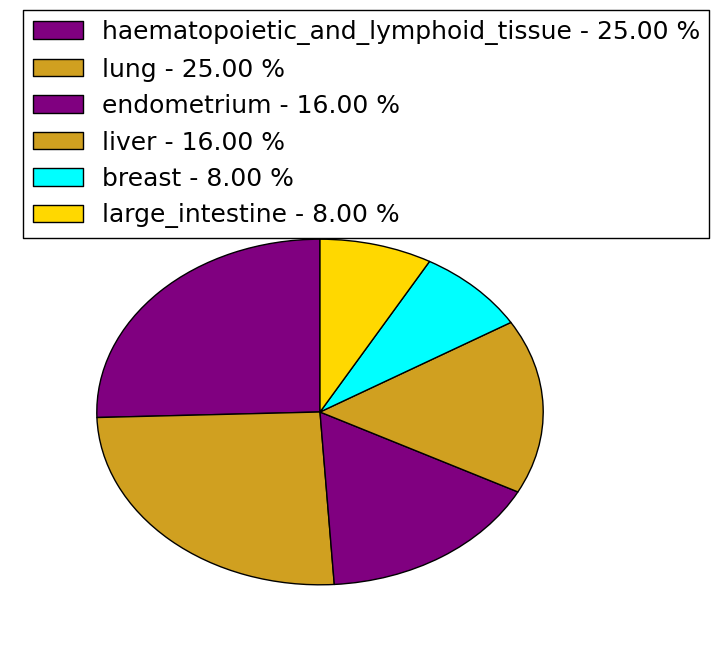 | 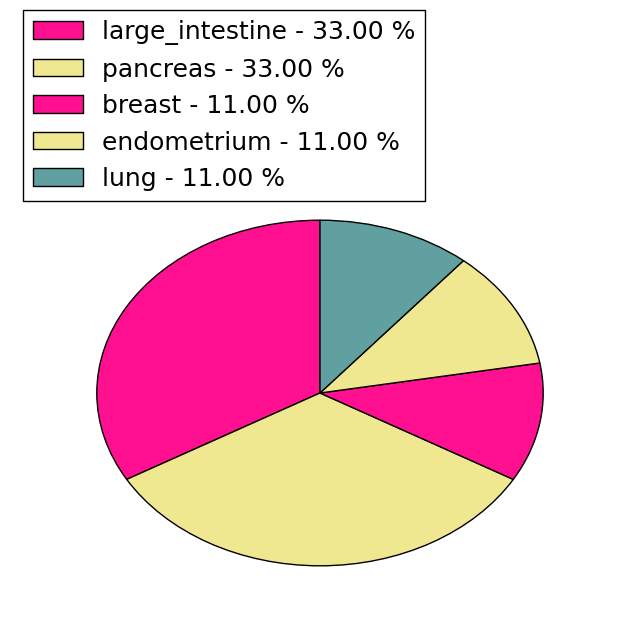 |
(# total SNVs=0) | (# total SNVs=0) |
| Top |
| * When you move the cursor on each content, you can see more deailed mutation information on the Tooltip. Those are primary_site,primary_histology,mutation(aa),pubmedID. |
| GRCh37 position | Mutation(aa) | Unique sampleID count |
| chr16:67970307-67970307 | p.V46V | 3 |
| chr16:67968568-67968568 | p.G239G | 2 |
| chr16:67969929-67969929 | p.L107fs*31 | 2 |
| chr16:67969930-67969930 | p.L107L | 2 |
| chr16:67970185-67970185 | p.A59T | 2 |
| chr16:67969531-67969531 | p.G151G | 2 |
| chr16:67970188-67970188 | p.R58G | 2 |
| chr16:67969901-67969901 | p.A116A | 1 |
| chr16:67970600-67970600 | p.Q18P | 1 |
| chr16:67968708-67968708 | p.P234P | 1 |
| Top |
|
 |
| Point Mutation/ Tissue ID | 1 | 2 | 3 | 4 | 5 | 6 | 7 | 8 | 9 | 10 | 11 | 12 | 13 | 14 | 15 | 16 | 17 | 18 | 19 | 20 |
| # sample | 1 | 2 | 1 | 1 | 2 | 4 | 3 | |||||||||||||
| # mutation | 1 | 3 | 1 | 1 | 2 | 4 | 3 | |||||||||||||
| nonsynonymous SNV | 3 | 1 | 1 | 1 | 2 | |||||||||||||||
| synonymous SNV | 1 | 1 | 1 | 3 | 1 |
| cf) Tissue ID; Tissue type (1; BLCA[Bladder Urothelial Carcinoma], 2; BRCA[Breast invasive carcinoma], 3; CESC[Cervical squamous cell carcinoma and endocervical adenocarcinoma], 4; COAD[Colon adenocarcinoma], 5; GBM[Glioblastoma multiforme], 6; Glioma Low Grade, 7; HNSC[Head and Neck squamous cell carcinoma], 8; KICH[Kidney Chromophobe], 9; KIRC[Kidney renal clear cell carcinoma], 10; KIRP[Kidney renal papillary cell carcinoma], 11; LAML[Acute Myeloid Leukemia], 12; LUAD[Lung adenocarcinoma], 13; LUSC[Lung squamous cell carcinoma], 14; OV[Ovarian serous cystadenocarcinoma ], 15; PAAD[Pancreatic adenocarcinoma], 16; PRAD[Prostate adenocarcinoma], 17; SKCM[Skin Cutaneous Melanoma], 18:STAD[Stomach adenocarcinoma], 19:THCA[Thyroid carcinoma], 20:UCEC[Uterine Corpus Endometrial Carcinoma]) |
| Top |
| * We represented just top 10 SNVs. When you move the cursor on each content, you can see more deailed mutation information on the Tooltip. Those are primary_site, primary_histology, mutation(aa), pubmedID. |
| Genomic Position | Mutation(aa) | Unique sampleID count |
| chr16:67968568 | p.G239G | 2 |
| chr16:67968747 | p.G221G | 1 |
| chr16:67970607 | p.A214S | 1 |
| chr16:67968770 | p.D213D | 1 |
| chr16:67968771 | p.E178K | 1 |
| chr16:67969349 | p.L177P | 1 |
| chr16:67969351 | p.L122L | 1 |
| chr16:67969883 | p.R120S | 1 |
| chr16:67969891 | p.A116A | 1 |
| chr16:67969901 | p.S108Y | 1 |
| * Copy number data were extracted from TCGA using R package TCGA-Assembler. The URLs of all public data files on TCGA DCC data server were gathered on Jan-05-2015. Function ProcessCNAData in TCGA-Assembler package was used to obtain gene-level copy number value which is calculated as the average copy number of the genomic region of a gene. |
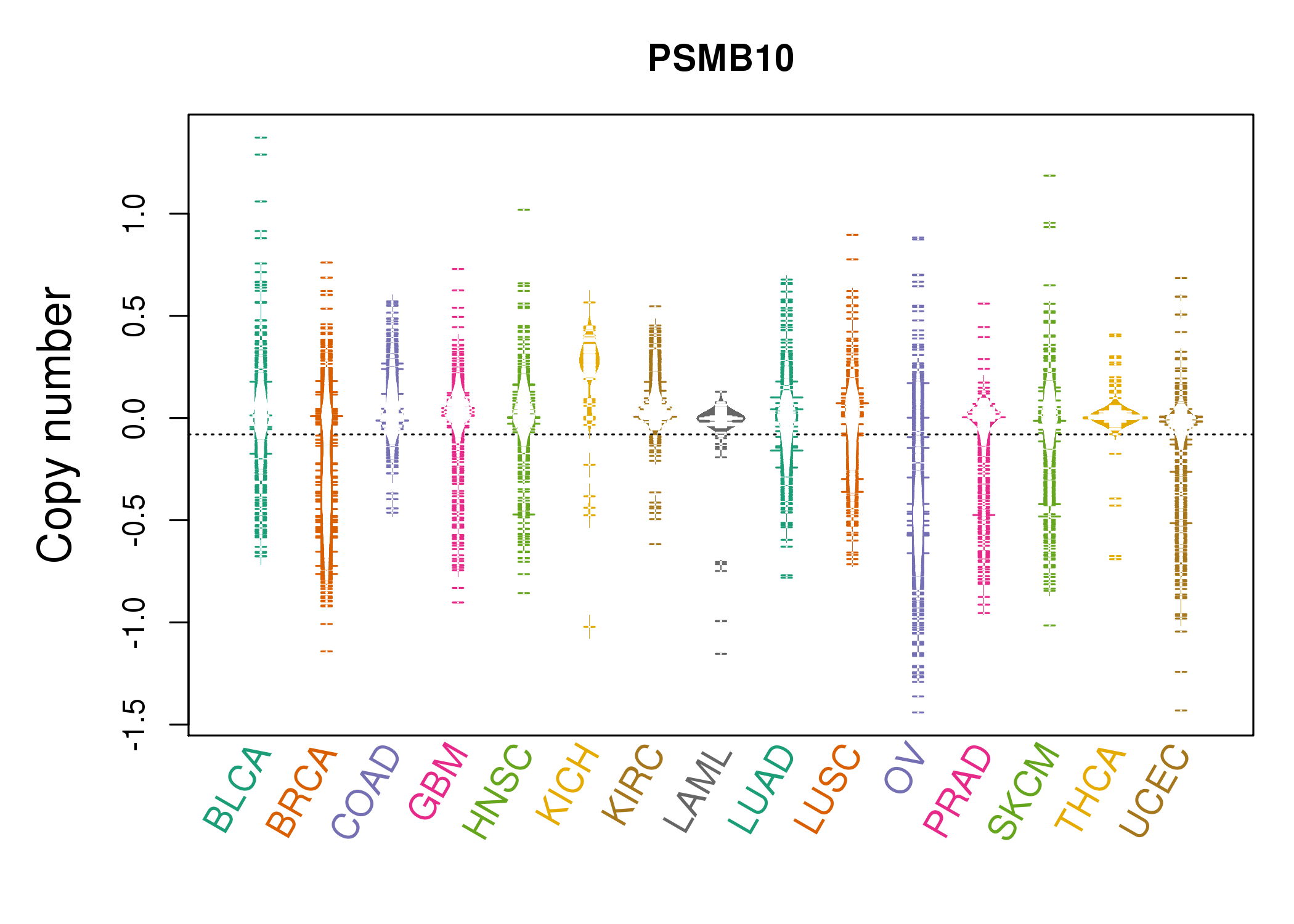 |
| cf) Tissue ID[Tissue type]: BLCA[Bladder Urothelial Carcinoma], BRCA[Breast invasive carcinoma], CESC[Cervical squamous cell carcinoma and endocervical adenocarcinoma], COAD[Colon adenocarcinoma], GBM[Glioblastoma multiforme], Glioma Low Grade, HNSC[Head and Neck squamous cell carcinoma], KICH[Kidney Chromophobe], KIRC[Kidney renal clear cell carcinoma], KIRP[Kidney renal papillary cell carcinoma], LAML[Acute Myeloid Leukemia], LUAD[Lung adenocarcinoma], LUSC[Lung squamous cell carcinoma], OV[Ovarian serous cystadenocarcinoma ], PAAD[Pancreatic adenocarcinoma], PRAD[Prostate adenocarcinoma], SKCM[Skin Cutaneous Melanoma], STAD[Stomach adenocarcinoma], THCA[Thyroid carcinoma], UCEC[Uterine Corpus Endometrial Carcinoma] |
| Top |
| Gene Expression for PSMB10 |
| * CCLE gene expression data were extracted from CCLE_Expression_Entrez_2012-10-18.res: Gene-centric RMA-normalized mRNA expression data. |
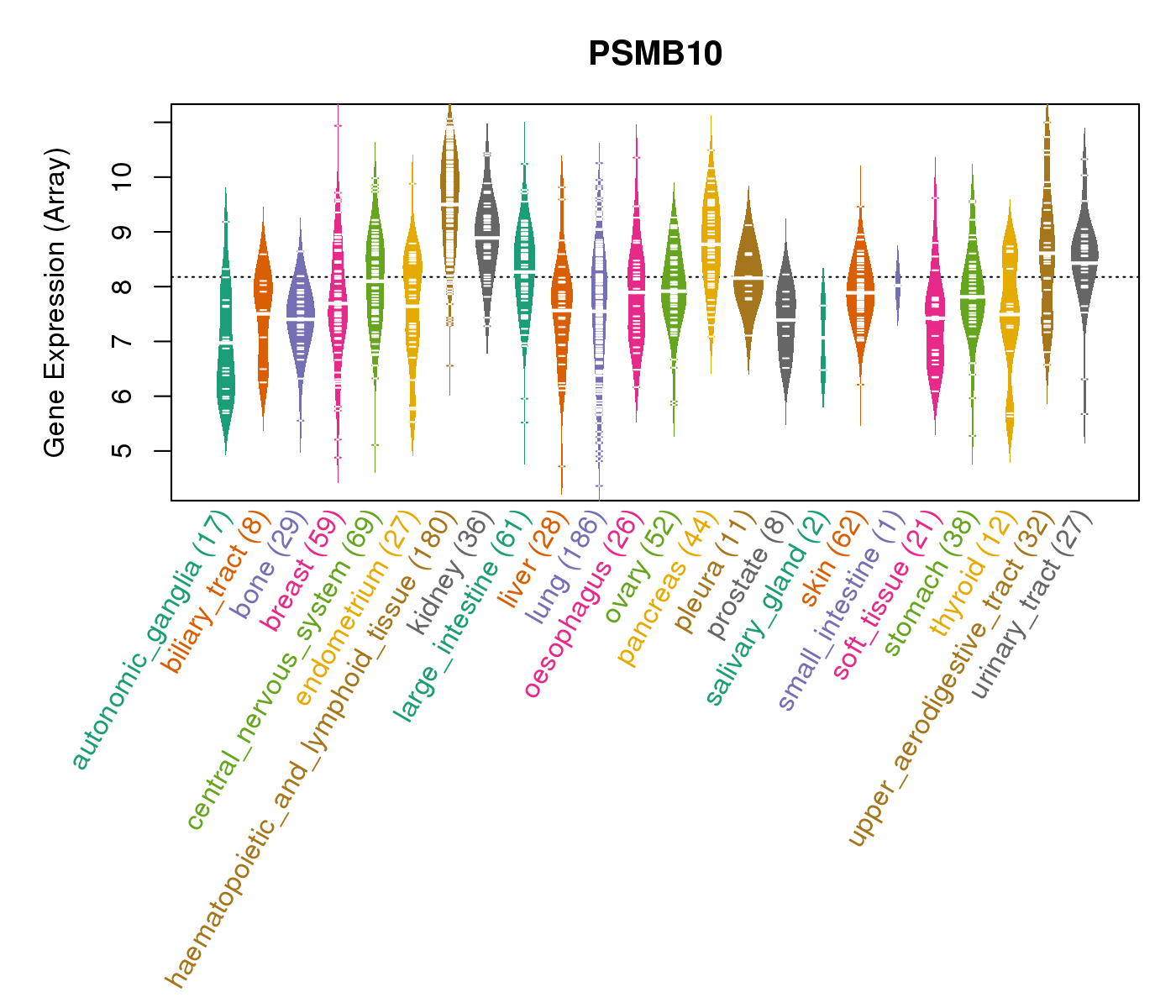 |
| * Normalized gene expression data of RNASeqV2 was extracted from TCGA using R package TCGA-Assembler. The URLs of all public data files on TCGA DCC data server were gathered at Jan-05-2015. Only eight cancer types have enough normal control samples for differential expression analysis. (t test, adjusted p<0.05 (using Benjamini-Hochberg FDR)) |
 |
| Top |
| * This plots show the correlation between CNV and gene expression. |
: Open all plots for all cancer types
 |
|
 |
|
| Top |
| Gene-Gene Network Information |
| * Co-Expression network figures were drawn using R package igraph. Only the top 20 genes with the highest correlations were shown. Red circle: input gene, orange circle: cell metabolism gene, sky circle: other gene |
: Open all plots for all cancer types
 |
|
| CCM2,COX4I1,CYBA,EFHD2,FLT3LG,GUK1,HCST, IRF3,LIME1,LOC606724,LST1,PSMB10,PSMB8,PSMB9, PSME2,RHOG,RNF166,IGFLR1,TRADD,TYMP,VAMP5 | BAX,COPE,CYBA,GALK1,IFI27L2,MBD3,NPDC1, PLSCR3,PSMB10,PYCARD,RALY,RBM42,RGS19,SCO2, SHKBP1,SIPA1,SIRT6,SNAPC2,SSBP4,TBCB,ZDHHC12 |
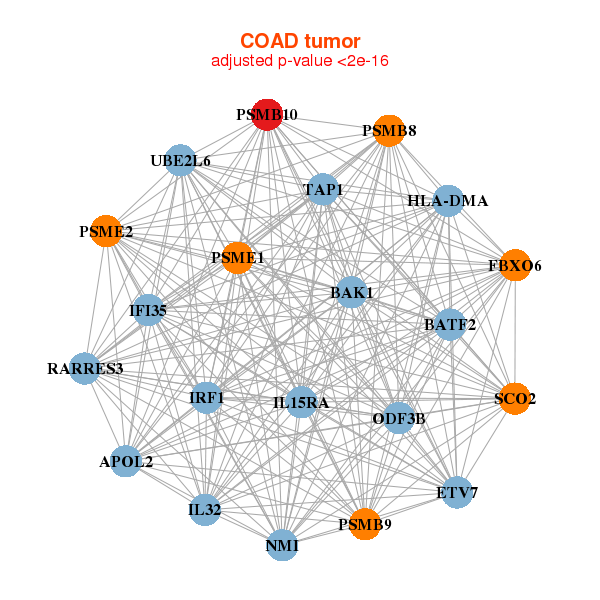 |
|
| APOL2,BAK1,BATF2,ETV7,FBXO6,HLA-DMA,IFI35, IL15RA,IL32,IRF1,NMI,ODF3B,PSMB10,PSMB8, PSMB9,PSME1,PSME2,RARRES3,SCO2,TAP1,UBE2L6 | BATF2,CARD16,EPSTI1,ETV7,FAM26F,GZMB,IFI30, IFI35,IRF1,PARP9,PSMB10,PSMB8,PSMB9,PSME1, PSME2,RARRES3,STAT1,TAP1,TRIM21,TYMP,UBE2L6 |
| * Co-Expression network figures were drawn using R package igraph. Only the top 20 genes with the highest correlations were shown. Red circle: input gene, orange circle: cell metabolism gene, sky circle: other gene |
: Open all plots for all cancer types
| Top |
: Open all interacting genes' information including KEGG pathway for all interacting genes from DAVID
| Top |
| Pharmacological Information for PSMB10 |
| There's no related Drug. |
| Top |
| Cross referenced IDs for PSMB10 |
| * We obtained these cross-references from Uniprot database. It covers 150 different DBs, 18 categories. http://www.uniprot.org/help/cross_references_section |
: Open all cross reference information
|
Copyright © 2016-Present - The Univsersity of Texas Health Science Center at Houston @ |









